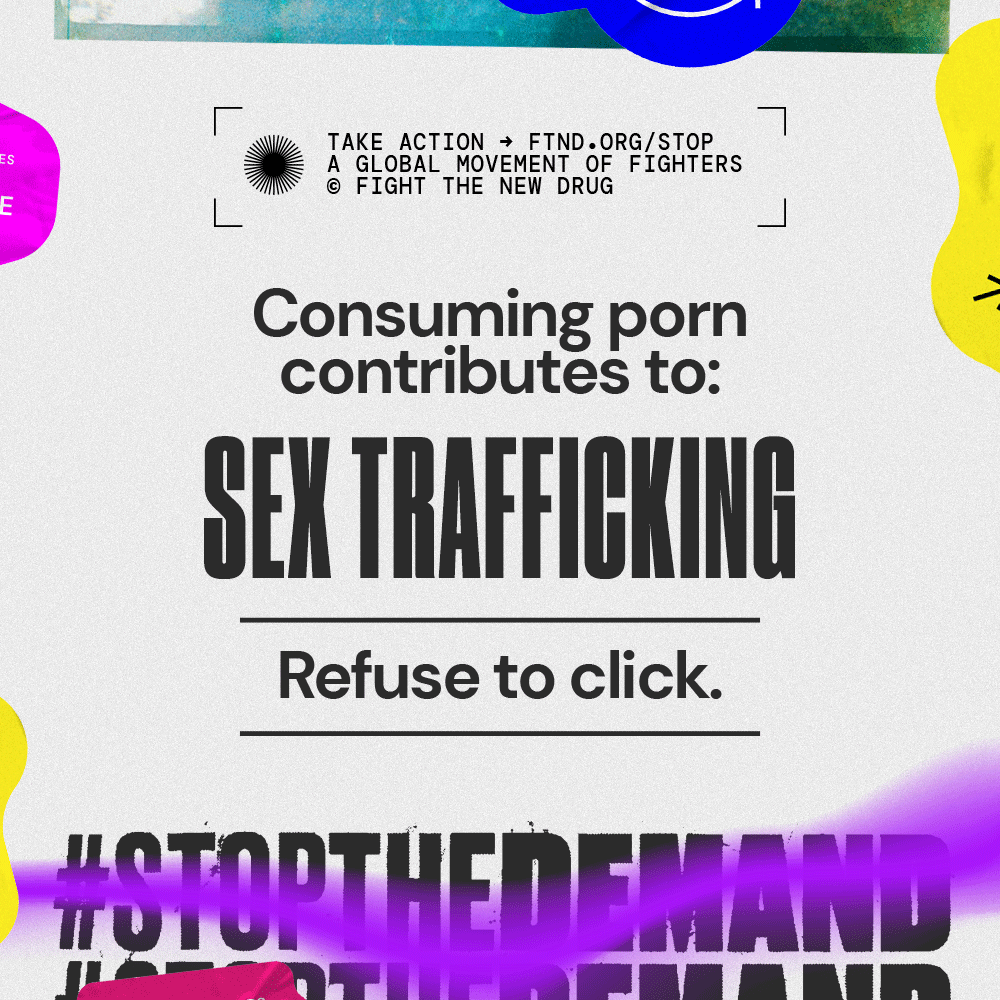Did you know some of the most popular mainstream pornography often shows violence and aggression—primarily toward women?
It isn’t difficult in this day in age to stumble across disturbing types of porn—in fact, they are some of the most sought out genres. Research has shown that most top-performing pornographic videos contain some type of physical violence (spanking, strangulation, and slapping—to name a few) as well as contain verbal aggression toward the victim.
While the amount of violence shown in porn is shocking, what is equally disturbing is the reaction of the victims. One study showed that 95% of the victims (who were nearly all women) were portrayed as neutral to the abuse or appeared to respond with pleasure.
Translation: pornography shows that violence is not only acceptable, but that it is sexy. (More on how the porn industry coerces some of its performers to behave on set later.)
Of course, not all pornography involves scenes of physical violence, but even non-violent porn—the vast majority of which portrays men as powerful and in charge, while women are submissive and obedient—has been shown to have a negative effect on consumers. In fact, research has shown that porn consumers are more likely to support statements that promote abuse and sexual aggression toward women and girls, even if what they’re watching doesn’t contain violence.
Fueling exploitation
Because of our society’s mainstream porn culture, sexual exploitation has been made to seem normal. Sex trafficking and other forms of exploitation have started to blend into what is considered normal and mainstream in our porn-obsessed society.
The truth is, human sex trafficking and exploitation don’t just happen in faraway countries or action-packed films. In fact, exploitation can—and often does—happen when a victim has given, and then tried to revoke, their consent.
We know from past performers accounts that this is often the case.
The demand for extreme, violent, and abusive content is rising with consumers’ requests, and porn performers are often coerced into doing violent and degrading scenes during production. They are either tricked into thinking the scene is going to be less violent than it ends up being, or they are threatened by various things (not getting paid, losing their bookings, getting blacklisted by production companies, wasting a day of expensive production if what was filmed was non-consensual) if they don’t participate at all or try and revoke their consent.
The Trafficking Victims Protection Act (TVPA) defines sex trafficking as a situation in which a commercial sex act is induced by force, fraud, or coercion. By that definition, these porn performers’ experiences of coercion and trickery meet the criteria for sex trafficking and exploitation.
The difference between consent and coercion
The trouble with pornography production is that it often blurs the lines between consent and coercion.
With the ability to create your own content, and with the amateur porn industry growing in popularity, it is difficult to know if the person you’re seeing on the screen has truly given their fully informed and enthusiastic consent, if they have been coerced into performing, or if they tried revoking their consent at any point during the production—even after they sign a contract.
When the porn industry uses coercive tactics to make content, they are also indirectly teaching the consumer that using the same methods in sexual situations is normal and acceptable. Also, when porn shows victims who seem to accept or enjoy being hurt, the consumer is fed the message that violence is sexy and that people like to be treated that way. In fact, study after study has shown that consumers of porn, both violent and nonviolent, are more likely to use verbal coercion, drugs, and alcohol to coerce individuals into sex.
One study showed that, of those whose partners regularly consumed pornography, 53% reported that they had been asked or forced to enact scenes they had been shown. Some partners of porn consumers also reported that their partner had asked, pressured, or coerced them into sexual acts they found uncomfortable or demeaning.
Does that sound like fully, enthusiastic consent? We don’t think so either.
Someone can agree to have sex, but what if during it, their partner suddenly started doing something unexpected that wasn’t initially consented to? And what if, afterward, the aggressive partner coerces their partner to say that everything was consensual so they don’t get in trouble?
These situations aren’t acceptable in reality, and they likewise should not be acceptable on porn sets. And yet, all too often, this is what can happen in the midst of producing content to meet consumers’ demands.
It is important to understand the difference between consensual and nonconsensual, and to know that true consent is educated and enthusiastic, and it can be revoked at any time for any reason.
Why this matters
The bigger the porn industry gets, the more challenging it will be for performers to step out and speak out without backlash when they’ve been exploited and abused in the name of sexual entertainment. As of now, there is no easily-accessible system of support or reporting for those who have been forced, frauded, and coerced into shooting even one porn scene, and blacklisting outspoken performers is currently the informal industry standard.
We are not claiming that all porn is nonconsensual, but rather, raising awareness that there is often no way to tell if the porn a consumer views is completely consensual or produced with coercion.
Related: By The Numbers: Is The Porn Industry Connected To Sex Trafficking?
And if you’re still not convinced content on mainstream sites isn’t all consensual, read this Jezebel.com story, this story on Daily Beast, this story on Complex.com, this Rolling Stone story, this Daily Beast story, this Bustle.com story, this story on CNN, this NY Post story, this Gizmodo.com story, this BBC report, this Florida Sun-Sentinel report, this Daily Wire story, this Buzzfeed News profile, and this UK Independent story for further proof that the mainstream porn industry features nonconsensual videos and videos of trafficked individuals. And yes, this includes videos on Pornhub and other mainstream porn sites.
Not clicking isn’t always easy, since porn is everywhere and so many people struggle, but it’s an action that we can all take, and it’s an action that matters.
Popular pornography doesn’t just show violence; it teaches the consumer that violence is normal and sexy, and it can directly or indirectly change the consumers’ beliefs and behaviors about coercive violence.
True consent is educated, enthusiastic, and authentic, and it is not given through coerciveness or threats. Just because a camera is there, doesn’t mean it’s consensual. Just because a performer looks like they’re having a good time doesn’t mean they aren’t being coerced behind the scenes. True consent can be revoked at any time, for whatever reason, and should ideally be without any fear of repercussions or reprimands.
Coercive violence really is the birthplace of exploitation; you can’t have one without the other, and the porn industry actively and knowingly participates in both.

Your Support Matters Now More Than Ever
Most kids today are exposed to porn by the age of 12. By the time they’re teenagers, 75% of boys and 70% of girls have already viewed itRobb, M.B., & Mann, S. (2023). Teens and pornography. San Francisco, CA: Common Sense.Copy —often before they’ve had a single healthy conversation about it.
Even more concerning: over half of boys and nearly 40% of girls believe porn is a realistic depiction of sexMartellozzo, E., Monaghan, A., Adler, J. R., Davidson, J., Leyva, R., & Horvath, M. A. H. (2016). “I wasn’t sure it was normal to watch it”: A quantitative and qualitative examination of the impact of online pornography on the values, attitudes, beliefs and behaviours of children and young people. Middlesex University, NSPCC, & Office of the Children’s Commissioner.Copy . And among teens who have seen porn, more than 79% of teens use it to learn how to have sexRobb, M.B., & Mann, S. (2023). Teens and pornography. San Francisco, CA: Common Sense.Copy . That means millions of young people are getting sex ed from violent, degrading content, which becomes their baseline understanding of intimacy. Out of the most popular porn, 33%-88% of videos contain physical aggression and nonconsensual violence-related themesFritz, N., Malic, V., Paul, B., & Zhou, Y. (2020). A descriptive analysis of the types, targets, and relative frequency of aggression in mainstream pornography. Archives of Sexual Behavior, 49(8), 3041-3053. doi:10.1007/s10508-020-01773-0Copy Bridges et al., 2010, “Aggression and Sexual Behavior in Best-Selling Pornography Videos: A Content Analysis,” Violence Against Women.Copy .
From increasing rates of loneliness, depression, and self-doubt, to distorted views of sex, reduced relationship satisfaction, and riskier sexual behavior among teens, porn is impacting individuals, relationships, and society worldwideFight the New Drug. (2024, May). Get the Facts (Series of web articles). Fight the New Drug.Copy .
This is why Fight the New Drug exists—but we can’t do it without you.
Your donation directly fuels the creation of new educational resources, including our awareness-raising videos, podcasts, research-driven articles, engaging school presentations, and digital tools that reach youth where they are: online and in school. It equips individuals, parents, educators, and youth with trustworthy resources to start the conversation.
Will you join us? We’re grateful for whatever you can give—but a recurring donation makes the biggest difference. Every dollar directly supports our vital work, and every individual we reach decreases sexual exploitation. Let’s fight for real love:



